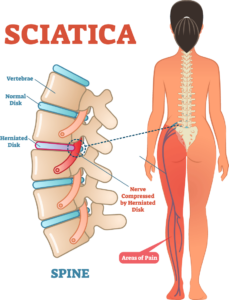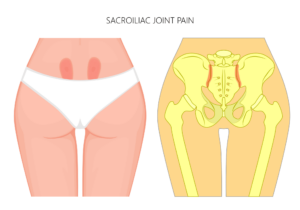Three Conditions that Mimic Sciatica
Have you recently searched your symptoms on the web and believe you have sciatica? Not so fast!
Sciatica is a very common condition that causes pain, numbness, and/or tingling extending from the lower back to the backside of the leg, usually stopping at the calf. However, sciatica isn’t the only condition that causes these symptoms, and misdiagnosis can lead to ineffective treatments.
Nobody likes to get treated for the wrong condition—it’s a frustrating and costly time-waster! If you’ve tried at-home treatments for sciatica and haven’t felt relief, it’s possible that you’ve diagnosed yourself incorrectly.
Save yourself time and money by getting it right the first time. See a doctor or lower back pain specialist, such as a Doctor of Physical Therapy, for an accurate diagnosis. At Back In Motion, we specialize in sciatica treatments, lower back pain treatment, and comprehensive care through physical therapy in Cape Coral and expert Fort Myers physical therapy. Contact us today to schedule your evaluation and take the first step toward lasting relief!
Knowing the difference between sciatica and similar conditions is crucial for effective treatment.
What is Sciatica?

Sciatica is a condition in which the sciatic nerve (the nerve that runs from the lower back to the feet) is compressed and therefore inflamed or entrapped.
If you have sciatica, you might feel pain and numbness that radiates from your lower back down to your calf. Usually, you’ll feel this pain and numbness only on one side of your body.
The symptoms of sciatica can range from a mild annoyance in one person to a completely debilitating condition in another. If left untreated, sciatica (or any other condition you might have) can worsen and prevent you from functioning normally.
Sciatica is typically caused by pinching of the nerve at the piriformis or hamstrings muscles. Similarly, a herniated disc or a bone spur (which is a bony overgrowth) on your spine which compresses the sciatic nerve can also mimic these symptoms.
Well, then what is causing my sciatica? You might ask…
If you really want to get to the root cause of your sciatica, you’ll need to see a lower back pain physical therapist.
Lower back pain physical therapists can effectively treat sciatica by treating everything that might have caused it (such as poor posture, tightness of your muscles, weakness of your muscles, or a herniated disc).
Only patients with severe sciatica symptoms such as incontinence or paralysis of the muscles in their leg may need to discuss the option of surgery with their doctors
Which Conditions Mimic Sciatica?
These three other conditions are commonly confused with sciatica due to their similar symptoms:
Joint Conditions
Certain joint conditions, such as spinal arthritis, are easily mistaken for sciatica. There are several joints located in the lower back and legs that can cause sciatica-like pain when they are irritated or worn down.

Sciatica is distinguished from some types of joint conditions if numbness or tingling is present. Joint conditions do not typically include numbness or tingling that extends from the lower back to the calf.
On the flip side, not everyone with sciatica experiences numbness or tingling. The only way to distinguish joint conditions from sciatica is to see a specially trained medical provider who can distinguish between the two.
Piriformis Syndrome
Do you have radiating pain, tingling, and/or numbness that seems to start in the buttocks rather than the lower back? If so, you may have piriformis syndrome rather than sciatica.

Piriformis syndrome is caused by spasms in the piriformis muscle, which is in the buttocks. If you have piriformis syndrome, the symptoms you feel are the result of muscle spasms irritating the nearby sciatic nerve.
You can find relief from these muscle spasms by visiting a lower back pain physical therapist, who is trained to identify why the spasms are occurring and how to subdue them.
Your physical therapist may combine strengthening and stretching exercises with specialized massage techniques to treat piriformis syndrome.
Sacroiliac Joint Dysfunction
It is possible to differentiate between sacroiliac joint dysfunction and sciatica based on symptoms alone & the treatment for these conditions is totally different.

Whereas sciatica is caused by the sciatic nerve getting compressed, sacroiliac joint dysfunction is caused by the sacroiliac joint (which connects the bottom of your spine to your pelvis) moving too much or too little.
All of that numbness, tingling, and/or pain that you feel radiating from your lower back down your leg might actually be the result of having a sacroiliac joint that moves too much (hypermobility) or too little (lack of mobility).
Manual therapy performed by a physical therapist can fix issues with the sacroiliac joint. If your joint lacks mobility, you can practice exercises to increase the mobility of the joint. If your joint is hypermobile, you should get a brace that is designed to decrease the mobility of the joint for when you are moving around.
If the Symptoms are the Same, How Will my Doctor Tell the Difference?
This is a common question among people suffering from radiating pain or numbness down the leg.
There are a few tests that your Doctor of Physical Therapy will perform to give you the right diagnosis.
Imaging tests such as X-rays and MRIs are useful to see if your sciatic nerve is being compressed by something but, these types of tests aren’t always needed to make a full diagnosis. If something is compressing your nerves such as a bone spur, bulging disc, or herniated disc, you would get diagnosed with sciatica, which is easily treatable by a lower back pain specialist in most cases.
Some joint conditions that mimic sciatica, such as arthritis, can also show up on X-ray results. Your doctor may also order blood tests if you are suspected to have arthritis.
GET YOUR FREE REPORT
Free Report Reveals … 9 Simple & Fast Strategies to Reduce Low Back Pain & Sciatica Pain
Piriformis syndrome is typically distinguished from sciatica and other conditions by ruling out other conditions through imaging tests and having the patient perform certain movements to see if they trigger pain.
Doctors can diagnose piriformis syndrome by lifting the patient’s leg slowly up toward the ceiling as the patient lies down. The location of the pain when the leg is lifted can help differentiate between sciatica, piriformis syndrome, and other joint conditions.
Many patients who visit a sciatica treatment specialist with symptoms identical to sciatica discover that they may have sacroiliac joint dysfunction instead. “That’s why the other treatments weren’t working,” their lower back pain specialists explain.
Luckily, there are some tests (other than imaging tests) that a doctor or lower back pain specialist can use to see if you have sacroiliac joint dysfunction instead of sciatica. These tests include:
- Distraction Test: Your doctor will press on the front of your hips while you lie on your back.
- FABER Test: Your doctor will press on your hips while you perform different movements, such as pulling your knee up to your chest and moving that leg from side to side.
- Sacral Thrust Test: Your doctor will press on the back of your hips while you lie face down.
- Sacroiliac Joint Injection: This is considered the “tell-tale” test if you are suspected to have sacroiliac joint dysfunction but didn’t show positive results on the other tests. Your doctor will inject a numbing solution directly into your sacroiliac joint. Your doctor will diagnose you with sacroiliac joint dysfunction if the pain diminishes after the injection.
If you have pain or tenderness during more than one of the tests (excluding the injection), you likely have sacroiliac joint dysfunction.
Do You Have Sciatica or a Condition that Mimics Sciatica? Here’s How to Treat It

Pain, numbness, and tingling that extends down your leg is alarming for most people. Fortunately, most conditions that cause these symptoms are treatable and not serious.
If you have sciatica, piriformis syndrome, sacroiliac joint dysfunction, or other joint conditions, your best solution is to see a Doctor of Physical Therapy that specializes in lower back pain and sciatica.
Lower back pain physical therapists will pinpoint the condition you have (if not already known) and what caused your condition. You can rest assured that you will receive treatments that are safe, proven successful, and personalized. Finally, you can get rid of your symptoms for good with the help of a lower back pain physical therapist.
Are You Ready to Feel Relief? Here’s a Quick Way to Get Started
Our lower back pain specialists have helped many patients overcome sciatica and other conditions that mimic sciatica.
We offer advanced treatments such as manual therapy, joint mobilization, and personalized exercises that can help you feel permanent relief.
Our awarded physical therapy clinic features skilled physical therapists who specialize in the spine and lower back.
We have 4 convenient physical therapy clinics. If you’re looking for a physical therapy in cape coral, we are accepting new patients.





